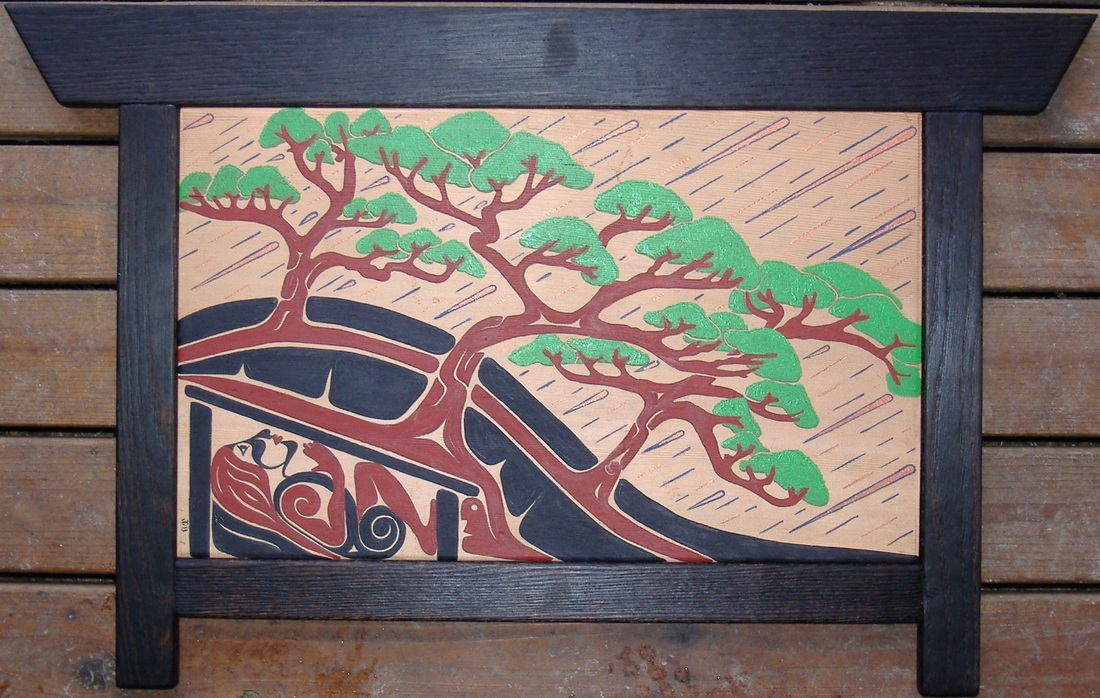SPIRITS OF OZETTE
ACRYLICS ON CEDAR W/ RED OAK FRAME
(WINTER 2013)
ACRYLICS ON CEDAR W/ RED OAK FRAME
(WINTER 2013)
Ozette (Hoset) was one of the five winter villages of the Makah Nation. About 300 to 500 years ago, a mudslide covered several houses at the Cape Alava village site with a thick, anaerobic glacial clay. The clay preserved the organic material culture of the people inhabiting the houses. I was fortunate enough to work at the Makah/WSU sponsored archaeological dig in 1975 and 1976 (where I met my wife, Leigh). When the houses were excavated, archaeologists found an amazing array of wooden artifacts representing everything of use within the houses at the moment of the mudslide. Living and working at the old village site for over a year had a profound impact on my life. It was also a very spiritual time for me, especially during the isolated, rainy winter of 1975. My painting hopes to reflect this special time for me. The red formlines symbolize organic aspects (life) while the black formlines symbolize inorganic aspects (death). Beneath the “stratigraphy” of the landscape abides a humanoid figure within a shed-roof Ozette-style cedar longhouse. A carved yew seal oil bowl found at the site inspired this image (see Richard Daugherty & Janet Friedman, “An Introduction to Ozette Art” in Roy L. Carlson (ed.), ©1976, Indian Art Traditions of the Northwest Coast, page 188). Several prints also acted as inspiration for this piece, including Roy Vickers’ 1975 print “Oola! Oola! Seal! Seal!” (see Edwin S. Hall, Jr., Margaret Blackman, and Vincent Rickard, ©1981, Northwest Coast Indian Graphics: An Introduction to Silk Screen Prints, page 65) and Moronobu’s “Cherry Blossom Time at Ueno” (see Ukiyo-e; 250 Years of Japanese Art, by Roni Neuer, Herbert Libertson, and Susugu Yoshida (©1979, Gallery Books 1988 edition, pages 56-59). Contemporary Kyoto painter Shoraku Sanjin’s 4-panel hand-painted screen (byobu) entitled “Pine Tree” was also very helpful. Finally, the opportunity to visit Neolithic chamber-tombs in Orkney (specifically Maeshowe & the Tomb of the Eagles) provided inspiration and background for the spiritual aspects of the painting. I made the frame out of red oak using pegged, hand-joined, mortise-and-tenon construction methods. I used the Japanese technique (shou-sugi-ban) of charring and oiling the oak to finish the frame.
DIMENSIONS: LENGTH: 21.5 inches
HEIGHT: 17 inches
PRICE $450
DIMENSIONS: LENGTH: 21.5 inches
HEIGHT: 17 inches
PRICE $450
